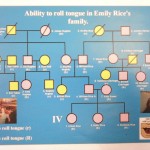Summary
This assignment is designed to allow students to answer the authentic question “How can a pedigree be used to make predictions for the inheritance of a trait in your own family?” Students create a pedigree (a genetic family tree) tracing the inheritance of a given trait through their own family. They must research data about their own family members’ phenotypes (traits), infer from that their genotypes (genes) and use all data to display their pedigree family tree. Student develop questions and choose the method in which to communicate with family members in completing the research. This form of study of genetics and inheritance is less abstract, and more relative, by connecting it to students own family history. The displayed pedigree can incorporate the names and photos of people in their family, along with any personal creative touches students choose, allowing students to represent their family identity, and work beyond the assignment parameters. The completed pedigrees are used by students to make predictions of certain traits within a family.
TIPC Ratings
Target (7) – In what might not seem like “traditional” research, students perform authentic investigation into the traits of their own family to search for actual inheritable body features. Student choose personally relevant and contemporary modes to connect with their resources, which in this case is at least eight family members. Research is conducted using interviews, photos, email, texting, Skype, Facetime, and even online sources like familysearch.org and ancestry.com. The teacher facilitates the lesson while students select information sources and construct questions to guide their research. Ultimately, the students synthesize the information in a powerful display of their family’s traits, interacting with the pedigree to make predictions about inheritance patterns. The teacher formatively assesses the students using the project rubric.
Approaching (5)- While this is an individual project in terms of the interaction within the classroom, students communicate deeply with family members. Students are challenged to create lines of communication within their family, and must collaborate with closely available resources to reach more distant relatives. The means of communication are also left for the student to choose from, depending on the what is most efficient for them.
Approaching (5) – Students use data collected to infer an inheritance pattern and individual family members’ genotypes for a given trait. This requires working “backwards” from known content to unknown along lines of Mendelian inheritance patterns. This is an authentic task that makes genetics relevant to their families and personal lineage. Organizing information and synthesizing it into a pedigree chart showing generational relationships requires a high level of critical thinking and problem solving.
Approaching (5) – The students “create meaningful work within the assignment parameters” by including photographs of their family and having freedom to choose elements and design that make the pedigree unique. The goal is a pedigree that shows genotypes, phenotypes, inheritance pattern, and illustrations of the trait/phenotypes and family members. But there are no limits to how a student can design and communicate this, allowing them to innovate beyond the assignment parameters.





